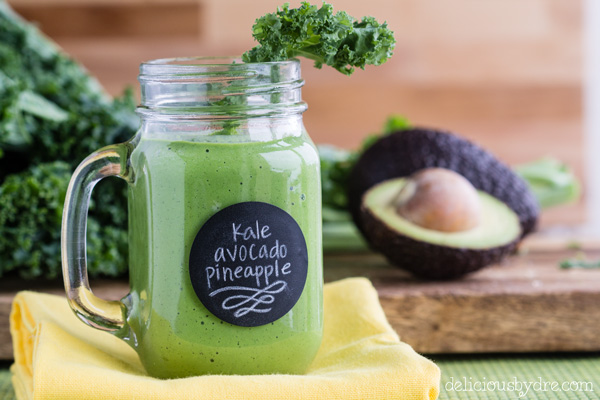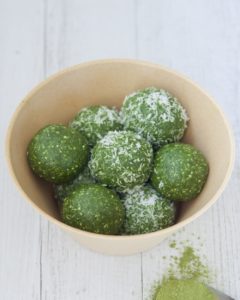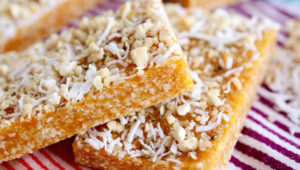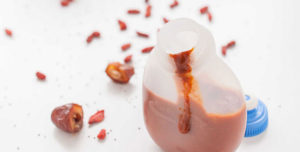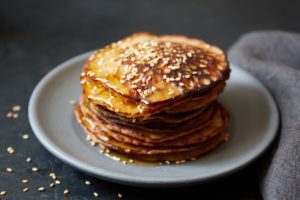Welcome to Nutrition
New Year, New You | Week 4
Week 4
Race Day Nutrition
GI Distress Isn’t Mandatory
You’ve put in the long runs. You’ve shown up for sunrise speed work. You even turned in early a few nights to make sure you got enough shut-eye.
Today is my day, you think as you approach the starting line.
Not so fast, rumbles your stomach, the archenemy of so many runners.
Take comfort in knowing that you’re not alone in your poop plight. A recently published study in the Human Kinetics Journal found that, during a 30-day period, male runners reported at least one symptom of GI distress on 84 percent of runs. Women, meanwhile, faced GI issues 78.3 percent of the time. Why? Because running, unlike cycling or swimming, includes a whole lot of jostling.
While GI distress is common—especially in runners—it’s also highly individual, both in how it presents and in how severely you suffer. There is a range of factors, including anatomy, genetics, propensity for nerves, and even some lifestyle choices such as diet and sleep patterns contribute to your own personal likelihood of uncomfortable (and highly inconvenient) stomach issues. This is why some lucky souls crush burritos at ultra aid stations while others are left to looking on longingly, knowing that even a single bite could wreak havoc on their insides all the way to the finish line.
So what are the alternatives? How can we fuel with real whole foods while still maintaining performance? Check out the sections below on how to turn your kitchen into a sports nutrition lab.
**Disclaimer** I am not telling you to give up packaged sports fuel, there is a time and place for everything (as long as it works for you). I am simply giving you information and suggestions on alternative ways to fuel your runs and eat clean.
Sports Nutrition 101
- The Basics
We’ve grown up on a diet of energy bars, lab-formulated drinks, and factory assembled gels. Don’t get me wrong—they work. Heck, they sometimes even taste pretty good. But there’s nothing like real food to settle your stomach and fuel your run.
If I had a dollar for every time an athlete told me they just “put up with the gut pain” because they think the bars and gels make them faster, I’d be a rich woman.
Your average energy gel isn’t an ideal food source. While they’re easy to slurp down at the tail end of a race or during a fast portion of a training run, densely sugared foods can dehydrate the body and facilitate overheating.
Gels are often comprised of maltodextrin, a longer molecule that requires final processing in the liver, which releases more heat. Surprised? Just check out your gel’s wrapper. It recommends you take in 8 to 10 ounces of water per serving to prevent dehydration, which is nearly impossible during a run.
- A Lesson On Digestion
Getting a little “science-y” on ya here…
The chewing process is what initiates the break down of food, through mechanical force and the chemical action of salivary enzymes like amylase, which digests carbohydrate.
But the process of digestion doesn’t actually begin when we put food in our mouth. It begins when we see and smell beautiful food. A positive emotional connection to food begins a cascade of physiological responses that preps us for the digestion and absorption of food. These responses range a broad gamut – from the release of digestive enzymes – to changes in the frequency and strength of peristaltic waves across our GI tract – to changes in our hormonal response. Accordingly, being attracted to what we eat is an important first step in maximizing food’s potential, even in a long event where food is typically thought of as just a fuel rather than a pleasure. (and has anyone ever looked at a gel packet and thought “what a pleasure it will be to shove this into my mouth”?)
After passing through the esophagus, food enters the stomach, which acts as a reservoir and mixing chamber that allows additional enzymes and acid to liquefy proteins, fats, and carbohydrates. The result is a semi-digested liquid called chyme, which is slowly and steadily passed from the stomach through the pyloric sphincter into the small intestine. The time it takes for foodstuffs to be liquefied and passed through the pyloric sphincter is referred to as the gastric emptying rate and can range from 10-60 minutes depending on the type of liquid or solid food consumed.
It’s in the small intestine or gut that nutrients are further digested and then absorbed into the body through a network of intestinal transporters. It’s at the small intestine that water is also absorbed – a process that occurs passively according to the solute concentration of fluid between the intestinal lumen (inside of the gut) and the blood, or that can be facilitated by the transport of glucose and sodium. The time it takes for the small intestine to absorb foodstuffs and water into the body is known as the intestinal absorption rate and depends on a host of factors including the type of nutrient, the available surface area of the intestine, the density of transporters, and the concentration of foodstuffs and water. While there are a number of models that predict this rate, anecdotally the highest rates of absorption that we’ve observed in pro athletes top out at about 100 grams of carbohydrate per hour and about 2.5 liters of water per hour.
**I am NOT telling you to consume 100g of carbohydrate an hour. I am just reporting the upper limits they’ve found in elite athletes. I can do longer events on 20-40g of carbs an hour and run just fine. I’ve coached athletes that require 90g of carbs. Each runner has their own individual sweet spot and I recommend you find yours**
- Where It Goes Wrong
Because digestion in the stomach ultimately leads to the creation of a liquid called chyme, liquid or semi-solid nutrition is often used in endurance sports as a way to speed up the gastric emptying rate, decreasing the demands of digestion in the stomach and ensuring more precise control of one’s nutrient profile.
While liquid or deconstructed nutrition is a good idea in theory, for many, this can lead to more problems than it solves. This is especially true when the rate of gastric emptying is much faster than the rate of intestinal absorption. When this happens, the gut can’t keep pace with the entrance of chyme and becomes the new bottleneck resulting in bloating and GI-distress often referred to as “gut rot.” As an analogy, the stomach is like a traffic light that meters the movement of cars onto a highway. If too many cars get past that light too fast, the risk is a traffic jam on the highway rather than faster travel times. Ultimately, the irony is that by trying to speed up the natural process of digestion, the balance between the stomach’s role as a reservoir for digested food, and the intestine as the gateway for food into the body can be severely disrupted.
Another problem is that highly concentrated solutions can impede proper hydration since the active transport of nutrients must take place before water can be absorbed. In some cases, when active transport is acutely overwhelmed, water can actually move from inside the body into the gut via osmosis causing severe bloating and/or diarrhea. This problem can be exacerbated by both liquid and solid food products with an excess of chemical ingredients like coloring agents, artificial sweeteners, flavoring agents, emulsifiers, and additional preservatives that aren’t recognized by the small intestine. These agents are termed “non-penetrating” and can accumulate in the gut further perpetuating GI-distress.
While solid food can help these problems from occurring, many energy-dense pre-packaged foods are very dry, making them hard to eat, requiring additional moisture for proper digestion, and often full of excess chemicals or synthetic ingredients that can contribute to gut rot. Add to this the fact that many pre-packaged foods intended for endurance sports just aren’t that appetizing only add insult to injury.
- What Does This Mean During Training & Racing?
For longer training sessions and events, rather than trying to outsmart the digestive process, it’s best to find a way for the process to occur as naturally as possible.
When temperatures are cold, more of a priority can be placed on food than water. In contrast, when temperatures are hot, even at a low sugar concentration, the higher volume of water and electrolyte replacement will increase the calories from drink mix, decreasing the amount of food needed.
Ultimately, it’s best to create a consistent and steady flow of energy that does not overwhelm the small intestine or gut. Likewise, using low sugar and higher sodium drink mixes maximizes hydration by minimizing the load on the gut.
Practically speaking, simple foods like bananas, dried fruit, nut butter, boiled potatoes with a little olive oil and salt, or for ultra events things like bone broth or sushi-rice cakes filled with either sweet or savory fillings do a great job. Even a homemade ‘cookie’ with minimal ingredients can work great over the course of a long event. That said, what we eat is a personal choice. What works for one runner may not work for another. What works for you in January might not work in June. The best thing you can do is to rethink what you’re eating for when you are pushing the envelope on your personal performance and develop a plan. Let that plan evolve and adapt each season.
Fueling Tips For Top Performance
- Train Your Gut
You don’t have to be at the mercy of your intestines. You can, at least to some degree, train your gut like you train your glutes and your lungs. Getting it right, however, takes time, work, and possibly some unpleasant experimentation.
Here’s how to do it.
- Step One: Go Long
When you exercise, blood is directed away from your intestines to provide oxygen to muscles. Digestion is a lower priority. But how much blood is shunted from your gut can be altered by your level of fitness. Experienced runners lose less blood from their innards than newbies do, according to a couple of studies. In theory, just logging frequent training runs should help soothe your stomach.
Intensity factors in here, too. The harder you’re working, the more blood your legs, heart, and lungs demand. That, in turn, means there’s little left to help keep your digestive system humming. Speed work and racing at peak ability are much more likely to cause GI distress. Test things by eating during a race when your heart rate isn’t approaching “overexcited jackhammer.” Having a good base of fitness means that you can recover much easier and get back below your lactate threshold, to an intensity where you can safely consume food, without jeopardizing your stomach’s ability to handle your fuel of choice.
- Step Two: Practice With Carbs
Consuming carbs while training can make it easier to take them in on race day. Choose a handful of key runs to test out your fueling options. It’s never too early to start practicing even with small doses of mid-race fuel, to give your body ample time to adapt.
- Step Three: Be Ready for It to Suck
Because it will. There was a period when you hate every run because you’re experimenting with fuel. Some things will work and some might not. Keep a log and track timing, GI issues, pace, heart rate and any other observations.
This is another reason why gut conditioning needs to happen early in a training cycle. A string of bad runs in the weeks before a race or even a few DNF results can screw with the mind of any athlete. Remind yourself that these bad runs are not a reflection of your fitness but simply a necessary evil to push through.
- Step Four: Set Yourself Up for Success
Start small – try tiny bites of food before slamming an entire bar or dried plum at once.
Start plain – begin with one ingredient foods like bananas, nut butter or dried figs.
Start close – test new fuels on runs that are close to home or even inside on a treadmill so you are close to a bathroom if need be.
- Step Five: Don’t Do Anything Stupid on Race Day
If you’re prone to digestive woes, you’re probably never going to have an iron-clad stomach even with training. In fact, the most consistent predictor of GI symptoms during a race is a history of those symptoms. So practice the techniques above, but know that being careful on and before race day is important, too.
Stay away from nonsteroidal anti-inflammatory drugs like Aleve, which have been shown to increase your chances of GI complications. (Plus, they may actually slow down your recovery time.)
Excess fiber and some kinds of fat, both of which slow digestion, should probably be avoided close to a race. Some runners may also need to avoid Fodmaps, or short-chain carbohydrates that many people struggle to digest well. Surprise: a lot of the foods runners love fall into this category, including things like garlic, onions, wheat, cashews, and many types of fruit. And while coffee is fine before a race, just make sure you drink it early enough to, well… you know.
Recipes
- Plain & Simple
Save some money and get more nutrients with five real food, no-fuss snacks.
Raisins
Dried fruit is a dense source of sugar, and still provides most of the same health benefits of eating fresh or raw fruits. About one-third cup of raisins will provide you with over 300 mg of potassium—an important electrolyte for hydration—and about 35g of carbohydrates. Toss this sticky snack in some salt if you want to add sodium to the mix too. They’re small and easy to consume and they pack easily in a zippered bag.
Stuffed Dates
Dates are another dried fruit and dense source of sugars. Conveniently, dates are easy to stuff (once you remove the pit), so it’s easy to customize this snack to your preferences as a replacement for sugary gels. I’m a big fan of adding nut butter and salt to dates. This mix helps keep energy levels more stable and can help replace electrolytes lost from sweat.
Pro tip: Fix these the night before and refrigerate. Otherwise, they can make quite a mess.
Nut Butter
While not technically a “food,” this food product (ground up nuts) can be a fantastic slow-burn fuel source. Just be sure to have some water close by to wash it down.
Applesauce & Baby Food
Applesauce—rich in carbohydrates, easy on the stomach, and with a welcome, real-food texture–for those who can’t quite stomach the gels. Packets of applesauce are easily portable and conveniently packaged. Look for them in the snack food and baby food aisles. Speaking of baby food, try the packets of mashed sweet potato, pears and beets.
Bananas
While many runners prefer to eat bananas before or after their run, a few slices of banana during a run can be helpful too. This fruit is relatively high in carbohydrates and naturally loaded with potassium. For a tasty treat, slice a banana and spread a thin layer of nut butter between slices, then freeze, and take them with you in a plastic bag.
- Homemade Energy Bars & Bites
Energy Bites
(I find these are perfect for snacking before and during my runs. There are literally hundreds of recipes online so if these flavors aren’t appealing, you go search for some that are.)
Almond Joy Bites
Ingredients
- 12 oz. (about 2 cups, loosely-packed) Medjool dates
- 2 cups almonds
- 1/2 cup shredded coconut
- 1/2 cup unsweetened cocoa powder
- 1 Tbsp. coconut oil
- 1 Tbsp. vanilla extract
- 1/2 tsp. almond extract (optional)
Directions
- Add dates and remaining ingredients to a food processor. Pulse a few times to combine, then use a rubber spatula to scrape the sides of the bowl.
- Blend the mixture for about 3 minutes, or until the mixture has moved past the crumbly stage and begins to clump and stick to the sides of the food processor.
- Use a spoon or small cookie scoop to measure out a tablespoon of dough (or your desired size) and roll it into a ball. If desired, roll the ball in a bowl of coconut flakes. Or just set it aside to eat as-is. Repeat with the remaining dough. (Alternately, you can flatten the dough into the bottom of an 8×8-inch parchment-lined baking dish, then cut it into bars.)
Store the energy bites in an airtight container for up to 2 weeks.
———————————————————————-
Chocolate Chip Bites (nut-free)
- 1 medium-size ripe banana
- 4 Medjool dates pitted
- 1/4 cup coconut flour
- 1/2 cup gluten-free rolled oats
- 2 Tbs dairy-free chocolate chips
Directions
- Into the bowl of a food processor or high-speed blender, add dates and banana, processing until dates have broken down and the mixture is smooth.
- Add coconut flour and oats, continuing to process until ingredients are well combined and the mixture sticks together easily.
- Transfer mixture to a bowl and stir in the chocolate chips by hand.
- Using a heaping tablespoon, roll dough between your hands to form balls. Set aside on a plate and repeat with remaining dough.
- Store balls in an airtight container in the fridge for up to a week, or freeze for longer periods of time.
———————————————————————
Matcha Energy Bites
- 1 cup almond meal
- 1/2 cup organic shredded unsweetened coconut flakes
- 1/4 cup vanilla protein powder
- 1/2 teaspoon matcha powder
- 1/4 cup cold pressed coconut oil
- 2 teaspoons organic maple syrup
Directions
- Combine all the ingredients in a mixing bowl
- Mix well using your fingers until combined.
- Add a little water if needed to assist mixing.
- Roll into balls and then roll in coconut.
- Refrigerate for 1 hour before serving.
- Enjoy. (Makes 12 bites)
———————————————————————-
Energy Bars
Apricot Seed Bars
Ingredients
- ¼ cup white sesame seeds
- 2 Tablespoons white chia seeds
- 2 Tablespoons hemp seeds
- ¼ cup sunflower seeds
- ¼ cup unsweetened shredded coconut
- About 8 dried apricots, coarsely chopped
- ¼ cup dried white mulberries or golden raisins
- 2 Tablespoons coconut oil
- 6 Tablespoons (1/3 cup) coconut nectar
- Pinch of sea salt
- ½ teaspoon vanilla extract
Instructions
- Line the bottom of a 9×5 inch loaf pan with parchment.
- In a medium-sized bowl mix together the seeds and dried fruit.
- In a medium-sized skillet heat the coconut oil, coconut nectar, vanilla extract and a pinch of salt. Whisk continuously to combine until bubbly. Let cook for 2 to 3 minutes until the mixture darkens in color and smells of caramel.
- Add in the mixed seeds and fruit and mix to combine with the coconut nectar caramel until well coated, sticky and warmed throughout.
- Pour into parchment lined pan and press down firmly with a spatula to smooth. Place in fridge to cool completely before cutting into bars.
- Cut into 6 bars and store in an airtight container in the fridge. Wrap bars in parchment to go.
*Notes – Gluten-Free, Grain-Free, Paleo, Vegan
———————————————————————-
Lemon Meringue Pie Bars
Ingredients
- 2 cups raw cashew pieces
- 1 + ½ cups big flake coconut
- ¼ cup maple syrup, Grade A
- 3 Tablespoons lemon zest
- 2 Tablespoon freshly squeezed lemon juice
- 2 Teaspoons vanilla extract
- ¼ Teaspoon sea salt
Instructions
- Reserve ½ cup of the big flake coconut to add later.
- Place all the ingredients, except the reserved coconut into a food processor and pulse until the mixture starts forming a dough.
- Add the remaining ½ cup coconut and pulse until your desired texture is reached. I like to stop when there is still visible pieces of coconut.
- Line an 8″x8″ baking pan with plastic wrap and pat/smooth the dough evenly into the pan.
- Holding the corners of the plastic wrap, lift the bars out of the pan and cut into 12 bars.
Serve within a few days, or wrap and freeze for later.
** Notes – I like to use cashew pieces because they’re much cheaper than whole cashews!
———————————————————————
Coffee Energy Mini-Bars
Ingredients
- 2 cups pitted Medjool dates
- 1 cup unsweetened shredded coconut
- 1 cup dried banana chips (unsweetened)
- 1 cup raw walnuts or pecans
- 2 tablespoons whole coffee beans or 1 tablespoon ground coffee
- 1/8 tsp ground cinnamon
- 1/4 tsp sea salt
- DirectionsIn a food processor, blend the pitted dates until finely processed.
- Add in remaining ingredients and process until a sticky mixture forms.
- Press the mixture into a parchment-lined dish using wet hands. The size of the dish will determine how thick the bars are.
- I used a container about 5”x8” large.
- Refrigerate for a few hours before slicing into squares. Store in refrigerator for up to a week.
- Do-It-Yourself Energy Gels
Raw Energy Gel
Ingredients:
6 raw dates
1/2 c. maple syrup/honey combination (play with the ratio to find your ideal combination.)
1 T. chia seeds
1 tsp. sea salt
1 T. carob powder
Directions:1. Place all ingredients in a mini-food processor, and let them sit for 1 hour.
2. Process until the mixture is almost smooth. (Leaving the dates a little chunky gives you something to chew while running…a nice distraction from the running.)
3. Scoop 1 1/2 tablespoon of gel into each snack-sized baggie.
4. Press the air out of each baggie, zip them up, and store the baggies in the fridge.
Makes five 1 ½ T. servings
——————————————————————-
Vega THRIVE Energy Gel
Base Recipe Ingredients:
2 packets SOS Berry Hydration
1 Tbsp honey or maple syrup
1 Tbsp ground chia seeds
2-3 dried dates
½ cup chilled liquid of choice (water, juice, green tea, yerba maté or herbal tea)
Steep and chill tea prior to blending; use two tea bags for ½ cup
1 Tbsp Coconut OilCoconut oil is a saturated fat, and source of medium chain triglycerides. It is easily converted to immediate fuel (rather than heading to storage). It can be found in most natural grocery and supplement stores.
½ tsp ground dulse (seaweed) or sea salt (to taste)
2 small zip closure re-useable baggies or re-useable gel flasks found at most running stores, carried on a hip belt, or hand-held.Preparation
Pre-soak the dried fruit in a bowl of warm water for a minimum of 15 minutes. Rinse and drain prior to use. If your recipe contains tea, steep and chill prior to blending.
When ready, place all ingredients in a food processor and blend all ingredients until well combined, and the mixture has a smooth, gel-like consistency. Spoon the mixture evenly into one-two small zip closure baggies, or gel flasks and refrigerate until use (ideally within 1-2 days)MACA CACAO-MINT ENERGIZER
Swap: yerba maté and/or green tea, mint flavor instead of water
Add: 1 tsp maca powder (look for a “gelatinized” version. Gelatinization is a process of heating maca that breaks down the starch bonds, making the active compounds more easily absorbed.)
Add: 1 tsp raw cacao powderAPRICOT CINNAMON CIRCULATION BOOSTER
Swap: 4 dried apricots in place of dried dates
Add: ½ tsp powdered cinnamon———————————————————————-
Tart Cherry Chia Seed Gel
Ingredients (makes 5 servings)
1/2 cup frozen tart cherries
1/2 cup orange juice
2 Tbsp chia seeds
1 tsp salt
1/4 cup plus 1 Tbsp honeyDirections
1. In a blender or food processor, blend cherries and orange juice. Add chia seeds and salt. (It will be slightly foamy on top)2. Let chia mixture sit for 5 minutes, then give a good stir. Let sit for another 2-3 hours in the refrigerator.
3. Add honey and thoroughly combine (it should be really thick). Pour slightly less than 1/4 cup of gel into 5 individual snack size plastic baggies.
4. Freeze until the night before a run. Place in fridge to thaw.
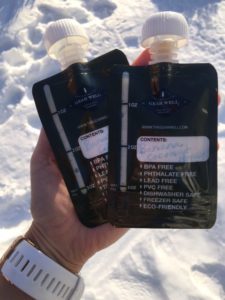
Try using these clean, reusable gel flasks to hold your homemade concoctions. - Budget Alternatives
CB&B Sandwich
The average American consumes 1,500 PB&Js before graduating high school. And with two simple tweaks—swapping peanut butter for cashew butter and jelly for mashed banana—the classic pulls double duty as an ideal endurance fuel. Pick any bread you like, I recommend trying gluten-free if you’ve been having GI issues. Wrap it in tinfoil, and force the malleable sandwich into any minuscule bag or pocket space you can find.
Why It Works: Bananas deliver the electrolyte potassium and an equal ratio of glucose and fructose, a combo researchers say can boost endurance and gut comfort. Cashews—one of the highest-carbohydrate nuts—pack in magnesium, a critical electrolyte that almost half of Americans don’t get enough of.
How to Tweak It: Want a bigger protein punch? Stir protein powder into the mashed banana. If you’re on a budget, swap the cashew butter for regular old peanut butter, which drops each sandwich’s cost to 53 cents.
How To Make It: Simply make a sandwich with the following ingredients.
2 slices Wonder Bread
1 ripe banana, mashed
2 tablespoons cashew butter
Calories: 395
Carbs: 53 grams
Fat: 20 grams
Protein: 9 grams
Price Per Serving: $1.20———————————————————–
Banana, Egg, and Arrowroot Pancake
Who doesn’t love pancakes?
Why It Works: Arrowroot, a starch made from the roots of several tropical plants, may reduce stomach issues. Eggs are a complete protein, meaning they contain the nine essential amino acids your body needs to function optimally and offer less risk of stomach issues compared to dairy-based proteins, which appear in classic flapjacks.
How to Tweak It: Add an extra egg white to increase the protein content. Or slather your favorite nut butter or honey between pancakes to boost the calories. You can drop the cost to just 45 cents per serving by using regular white flour if your stomach allows.
How To Make It: Mix the following ingredients into a batter. Pour the batter into a hot pan and cook until done, flipping once.
1/2 cup arrowroot flour
1 ripe banana
1 egg
Calories: 397
Carbs: 83 grams
Fat: 5 grams
Protein: 7 grams
Price Per Serving: $1.25——————————————————————-
Rice and Ginger Balls
Ultrarunner Nickademus Hollon, who won the notoriously difficult Barkley Marathons in 2013 and has routinely dealt with stomach issues, discovered these treats while testing out different on-trail foods. The secret ingredient? Ginger, which the Chinese have been using to aid digestion and treat upset stomach for more than 2,000 years. Hollon says the balls are cheap (this is the cheapest recipe here) and easy to make.
Why It Works: Sticky rice delivers an easy-to-digest endurance fuel. Science backs the ancient Eastern remedy—ginger can settle your stomach, and may also relieve post-exercise soreness
How to Tweak It: Splash a dash of soy sauce into the mixture to increase the salt content and to add the complex flavor of umami, a Japanese word that roughly translates to “deliciousness.” Or toss in some chopped pecans for a boost of high-energy fat and tasty texture. They’re the highest-antioxidant nut, according to a USDA study.
How to Make It: Mix the following ingredients together and shape into ping-pong-sized balls. The recipe makes about eight.
2 cups cooked sticky rice
1 ounce pickled ginger, chopped
Calories Per Ball: 48
Carbs: 11 grams
Fat: 0 grams
Protein: 1 gram
Price Per Serving: $0.12——————————————————————–
Avocado Mash
Avocados—once a rare, seasonal treat—are now mainstream. Mashed in a Ziploc with a little salt, avocado is the perfect packable “keto” fuel.
Why It Works: A medium avocado has 250 calories and 20 vitamins and minerals. Beyond endurance, the avocado’s general health benefits are stellar. Eight studies show that their fats can boost heart health and promote healthy aging. Sea salt contains more of the electrolytes and minerals you lose through sweat compared to regular salt.
How to Tweak It: If you’re not on the keto bandwagon but like the idea of an all-natural endurance paste, add carbs to the mash in the form of a slow-roasted sweet potato.
How to Make It: Dump all ingredients into a sealable plastic bag. Mash them together. Mid-endurance effort, bite off a corner the bag and squeeze the contents into your mouth.
1 medium avocado
1 pinch sea salt
Calories: 250
Carbs: 13 grams
Fat: 23 grams
Protein: 3 grams
Price Per Serving: $1



